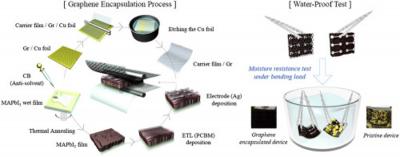Researchers at Pusan National University, Gwangju Institute of Science and Technology and the Korea Institute of Machinery & Materials (KIMM) in South Korea have tackled perovskite solar cells' stability issues by designing a graphene-based encapsulation technique.

The team introduced a highly flexible and stable graphene encapsulant by adopting the dry transfer method based on a roll-based process.
The graphene-encapsulated perovskite films reportedly exhibited outstanding stability compared with a pristine film, and the graphene device retained 95% of its initial efficiency after 100â¯h of exposure to 85'90% relative humidity and retained 82.4% of its initial efficiency after 3700â¯h in ambient air.
In addition, graphene-encapsulated flexible PSCs exhibited enhanced stability even when subjected to bending stress while submerged in water.
Based on the results, the researchers expect the proposed graphene encapsulation technique to be compatible with diverse graphene applications and to contribute to the development of not only stable perovskites but also next-generation flexible solar cells such as organic and quantum-dot solar cells.



